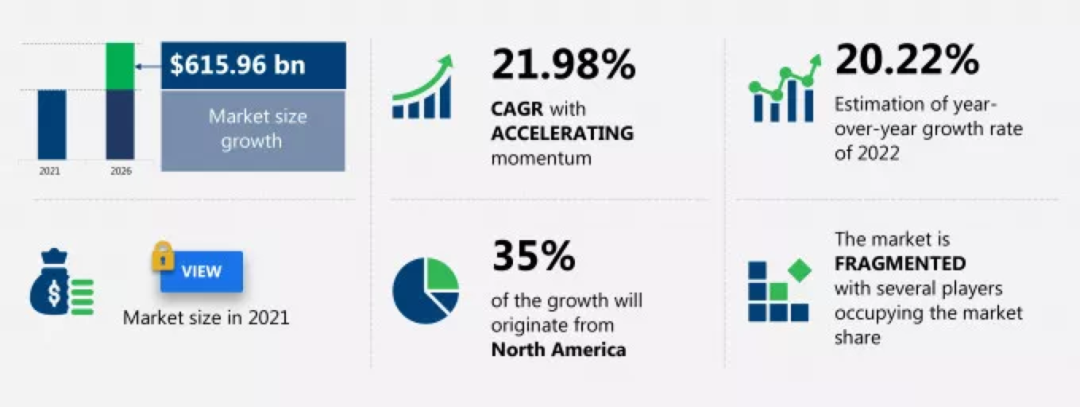Data center networking trends to watch in 2023

Data center networking trends to watch in 2023

According to research firm Technavio, the data center market share is expected to increase by $615.96 billion from 2021 to 2026, and the market will accelerate at a CAGR of 21.98%.

Key drivers for the data center market
One of the key factors driving the growth of the global data center market is the adoption of multi-cloud and network upgrades to support the rise of 5G.
Enterprises are adopting multi-cloud architectures to prevent data loss or downtime due to localized component failures, ensure security compliance, and meet workload requirements.
The demand for global deployment of 4G/5G networks will also increase during the forecast period. With the implementation of 5G technology and the speed increases that come with it, the speed at which data is generated, transmitted, and consumed will also accelerate. This will drive the need for network infrastructure upgrades in existing data centers, and new data centers will be built closer to the data source to reduce latency, which will have a positive impact on the market.
Key challenges in the data center market
Cybersecurity issues will be a major challenge for the growth of the global data center market.
Data is one of the main assets of a business, and it can generate potential revenue by analyzing past trends and make decisions for the future. However, the security of sensitive data is a major concern for businesses.
With the popularity of cloud services and the adoption of IoT-based solutions, the threat of cyberattacks is on the rise.
With cybercrime on the rise, corporate server assets are at risk of being hacked, and they can exploit IT security breaches to gain access to corporate servers.
Data Center Network Trends
Changes in security in and out of the data center: Hybrid and multicloud initiatives are driving changes in data center networks, including new security deployments, greater automation, and evolving network operations strategies.
The proliferation of cloud services and colocation facilities, in turn, has contributed to the growth of SD-WAN and SASE technology deployments to secure access to these resources.
"Driving customer and employee access to applications through the cloud front end means pushing security and VPN ingress capabilities into the cloud, and even more so SASE/SD-WAN," SAYS CIMI'S Nolle. This means that SD-WAN may become more important than MPLS VPN. ”
Mauricio Sanchez, Director of Cybersecurity, SASE and SD-WAN Research Director, Dell'Oro Group, said: "In Q3 2022, SASE revenue grew by more than 25% year-over-year for the seventh consecutive quarter, demonstrating the importance enterprises place on SASE. Unlike some other cybersecurity markets tracked by Dell, we expect high-priority investments to continue, with the SASE market expected to exceed $8 billion in 2023. ”
Research firm Gartner has higher expectations for SASE, predicting global SASE spending to reach $9.2 billion in 2023, up 39% from 2022.
In a recent report, Gartner wrote, "Cloud and edge computing adoption has fundamentally changed access needs. For most organizations, there are now more users, devices, applications, services, and data outside the enterprise than inside. Using a traditional perimeter-based approach to secure anytime, anywhere access introduces complexity for security administrators and users. ”
Security inside data centers is also changing.
In particular, many enterprises are considering the advantages of Fabric networking technology. Fabric networks typically use a mesh of connections between access points, switches, and routers to transmit data to their destination.
When it comes to management, enterprises can strengthen hybrid environments and simplify security management with greater automation and abstraction.
In its recent Global Hybrid Cloud Trends report, Cisco noted, "Security teams can mitigate the greatest risk of misconfiguration and operational errors if they can implement tools that use a common framework for security management across multiple clouds." ”
Automation is key to hybrid operations: Overall, infrastructure automation is critical to cloud scale and efficiency. Cisco found in its research that 49% of organizations surveyed have deployed automation.
Cisco says this is an area that has traditionally been underinvested.
There are significant differences in the adoption of infrastructure automation compared to overall cloud usage. Of those organizations that use only a single public cloud, 39% have deployed automation. Operators with more than 10 clouds report a higher level of automated deployment, reaching 55%.
Leveraging automated tools, such as IT operations platforms delivered as cloud-based services that support infrastructure lifecycle management, can further help understand the complexities of hybrid cloud.
Brad Casemore, vice president of data center and multicloud networking research at IDC, also emphasized the growing importance of automation, "We expect tremendous growth in the use of automation by global cloud networks from AWS, Google Cloud, Microsoft Azure, Oracle and others. ”
Casemore says intelligent network automation will help bring consistency and simplicity to networks that span multiple clouds, which matters.
In addition, by 2023, AI/ML will begin to play an increasing role in network automation. "The most impactful use case will be the digital twin twin that supports AI/ML, which will become part of the standard network operations process for large enterprises."
白盒数据中心交换
Nolle 表示,数据中心交换可能是未来白盒网络元素的热点。
根据 650 Group 的分析师 Alan Weckel 的说法,未来几年 SONiC 的采用率将大大超过整体市场增长。
Weckel 预测全球 SONiC到 2026 年收入将超过 50 亿美元。此外,Dell’Oro 预测,到 2026 年,部署在企业网络中的交换机中将近 10% 将运行 SONiC。
网络运营、技能的提升
企业数据中心 IT 专业人员处理这些网络挑战的方式也将发生转变。
In its 2023 Cloud, Data Center, and Edge Infrastructure Planning Guide, Gartner describes an emerging service-centric networking stack anchored by a service connectivity layer that sits between the physical network infrastructure and higher-order services that will communicate through the network.
According to Gartner, "The underlying networking layer includes traditional network devices and fabrics such as IP address management, routing, DNS, load balancers, and firewalls. The service connectivity layer adds a degree of abstraction on top of the physical network. ”
So, according to Gartner, developers don't need to interface directly with the network, but only with the service connection layer.
AI powers NetOps
Jeff Aaron, vice president of corporate marketing at Juniper, said AI-driven support will be an essential part of IT operations teams by 2023.
"The network will continue to expand and increase complexity, pushing network support teams to their limits. By 2023, many IT operations teams will realize that they need the help of AI-driven support tools and problem-solving mechanisms to resolve network failures. We expect to see more AI-driven support adoption to proactively resolve network issues and reduce time to resolution of network failures, thereby reducing operational costs and alleviating the staffing shortages IT operations teams currently face. ”